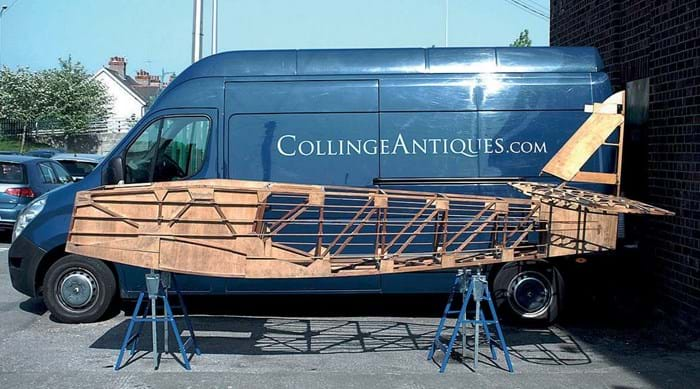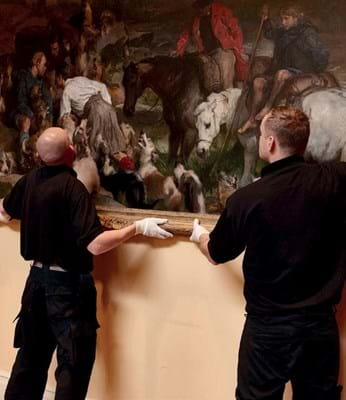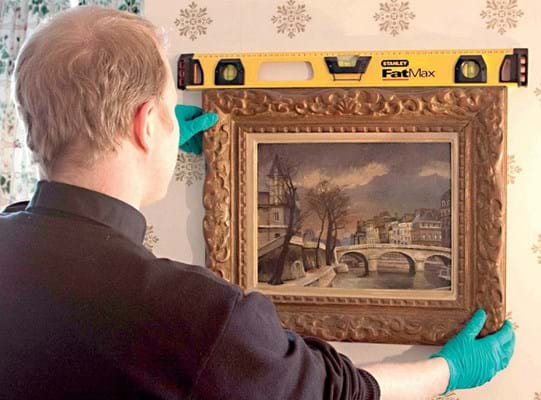Better, faster, cheaper – as ecommerce has grown, so have consumer expectations on service and price. The low-cost, fast turnaround, ‘one-click’ delivery services, driven by the likes of Amazon Prime, have fed expectations of cheap and speedy home delivery and given rise to cut-price courier companies like Hermes.
In much the same way, today’s thriving online auction market has pushed the art shipping sector to offer a simpler, faster and more economical service for both national and international bidders.
But, unlike giant internet retailers such as Amazon who handle everyday items, the art shipping sector has to contend with unique challenges that make the process more expensive. The handling of art and antiques, which are often fragile, valuable and, in many cases, irreplaceable, requires experience and expertise – skills that count for much in this sector.
Pricing and speed
Value, fragility, time, the amount of labour required and destination all play a part in the cost of delivering art and antiques.
Typically, prices for delivery of a low-value item requiring a basic ‘no-frills’ option start from around £15, but a service needing bespoke crating and end-to-end haulage can run into thousands of pounds. Delivering a five-piece silver coffee service within the UK should roughly cost around £35 (plus VAT) with most carriers, while a standard piece of antique furniture may cost anywhere between £50-200.
Lois Jay Biddlestone, UK Auction Logistics manager at Mail Boxes Etc. (MBE), works under its ‘Auction Logistics’ brand with nearly 100 auction houses through thesaleroom.com (a sister brand to Antiques Trade Gazette). The firm supplies services at both ends of the spectrum and “pretty much everything in between”, Biddlestone says.

Fragile ceramic pieces individually wrapped and placed in a specially designed box to keep them secure. Photo courtesy of Mail Boxes Etc.
MBE’s most common service is a four-working day turnaround, from collection to delivery to the customer’s door, on a tracked, signed-for service. On average, it takes only a day longer for major EU destinations and a couple of days for US, Canadian and major non-EU destinations. In theory, a successful bidder using this service could have an item delivered anywhere in the world within eight working days of winning an item at auction, provided the auction house and buyer also play their part.
“ Speed of delivery is often dictated by how quickly a customer pays for their lot at auction
“Speed of delivery is often dictated by how quickly a customer pays the auctioneer for their lot, how quickly we are instructed to visit and make the collection, and our arrangements and collection schedule with the auction house,” says Biddlestone.
What’s new
GPS tracking and improved communication have led to a more efficient delivery process with less waiting time at the delivery end. It is now standard for most domestic carriers to email with a two-hour delivery slot and, if the customer wishes, keep up to date via text messages.
But shippers specialising in art and antiques tread a fine line between embracing innovation and offering a personal service.
“There are new developments happening all the time in terms of shipping,” says Ben Loosely, logistics manager at JenTel Packing, the Basildon-based specialist shippers in antiques and other fragile items. “If you look at Amazon, it is very innovative in using automation, but this does take away the more ‘personal’ service, something we pride ourselves on as a family business.”
The ability to calculate the costs of shipping for bidders before they buy at auction is another online tool that has grown in sophistication. A new option on the MBE website showcases the sales of several hundred auctioneers, with browsers of the site able to select a lot and request a tailored quote directly from the company.
Other improvements include the materials used to keep art and antiques secure in transit. Long gone are the days when crates were bulked out with hay. Today shippers favour robust, light-weight materials such as special types of foam. Regulated conditions during transit for delicate items, such as paintings, have also become more widely used. Gander & White, for instance, has equipped all its vans with climate control.
Brexit challenges
For an industry like shipping, Brexit has thrown up a considerable amount of uncertainty.
“We believe that it is likely to mean stricter customs duties and inspections, longer transit times and will probably be more expensive to some destinations, with the introduction of tariffs,” says Biddlestone. The rules for shipping to the EU will more closely reflect the existing rules for shipping to non-EU destinations, she adds.
On the plus side, says Loosely, this could mean the market will open up for shippers as trade is expanded outside of the single market. “There should, in theory, be many more overseas buyers wanting to cash in as the value of the pound fluctuates over Brexit uncertainties, therefore international shipping would increase. However, I can foresee the current rate of European shipments reducing as an impact of Brexit.”
Oliver Howell, European managing director at Gander & White, is confident the disruption to business will be minimal at the top end of the sector, but expects to see a rise post-Brexit in the use of bonded facilities – effectively the equivalent of a freeport in places like Switzerland.
“Clients can bring works into the country and store them with us without paying any duties and taxes,” he says. “They can come in and view them in one of our viewing rooms without technicallyimporting them into the country”.
Keeping up to date with exportation regulations, particularly regarding ivory-based objects and antique firearms, is another challenge for shippers.
“Export regulations do seem to change quite dramatically and without much guidance or assistance,” says Loosely. “These sorts of items are a legal nightmare and we do our best to avoid them as it can cause massive complications for all parties. These items are straightforward to pack but the cost of getting it legally wrong does not bear thinking about.”
Going in-house
Many auction houses and dealers have traditionally preferred to outsource the packing and delivery to shippers - “they’re the specialists”, as Colin Young of Golding Young & Mawer puts it.
Yet an increasing number are taking on the packing task themselves in order to offer a more complete service. Fellows of Birmingham, which specialises in jewellery, watches and silver, has two full-time members of staff dedicated to postage and packing. “We think it is really important that we provide a speedy, secure and helpful service to people buying from us,” says Alexandra Whittaker, head of communications at Fellows. “We want to make sure they receive their purchases as soon as possible so that they can enjoy them. By keeping 90% of our postage in- house we are able to offer the best service possible to our customers.”
Export rules for ivory- objects and antique firearms do seem to change dramatically
East Bristol Auctions has offered in-house packing since the firm’s inception six years ago. “It’s hard work and objects don’t go out of here as quickly,” says owner Evan McPherson.
“But at the end of the day it’s one less barrier to a sale if you have a packing and postage option.”
Auction houses such as Hansons in Derbyshire and Special Auction Services in Newbury also pack and dispatch most items in-house.
“We like to offer our buyers a full and complete service. As with any major business selling products, if we sell online we should be able to deliver to online buyers,” says Hansons managing director, Charles Hanson.

Collinge Antiques in North Wales has invested in its own small fleet of delivery vans. Photo courtesy of Collinge Antiques.
Collinge Antiques, a dealership in north Wales, has gone a step further. The shop prefers to make its own deliveries within the UK and has a small fleet of vans to do so. It is not the speediest option, admits shop manager Tom Burgess. Clients have to wait for the van to be full before items can be delivered, which can take up to a fortnight.
But the rationale for dealers in particular to maintain control over the so-called ‘final mile’ of packaging and shipping is a strong one, Burgess argues. “I can say from bitter experience there is the potential for things to go very wrong,” he says.
“After working so hard to buy something, move it, restore it, photograph it, list it online and sell it, why would you then hand over the last piece of the process to someone else?”





















